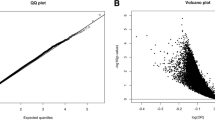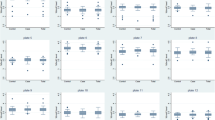Abstract
The role of environmental carcinogen exposure in breast cancer development has long been suspected, but no specific association has been identified so far. A few molecular epidemiology studies reported that DNA adducts detected by different methods are associated with a modest increase of breast cancer risk. We aimed to evaluate the association between bulky DNA adducts, detected by the 32P-postlabelling method in peripheral leukocytes, and the risk of developing breast cancer in the female Italian cohorts of the EPIC (European Prospective Investigation into Cancer and nutrition) study. By using a nested case–control design, breast cancer cases identified in the follow-up of over 30,000 women of EPIC-Italy study have been matched to controls by specific criteria. We measured the levels of bulky DNA adducts by the 32P-postlabelling method in peripheral leukocytes donated at enrolment. Conditional regression analyses adjusted for selected potential confounders were used. Results on DNA adduct levels were available for 292 cases and 292 matched controls. The mean DNA adduct levels were similar in both groups (P = 0.62). Multivariate regression analyses failed to show any significant association between bulky DNA adducts and breast cancer. Our results do not support any association of breast cancer risk with exposure to environmental carcinogens as measured through the levels of bulky DNA adducts in pre-diagnostic white blood cells. Larger studies by using different methods and/or biomarkers are needed to better evaluate the role of specific environmental carcinogens in breast carcinogenesis.

Similar content being viewed by others
References
Ferlay J, Shin HR, Bray F, Forman D, Mathers C, Parkin DM (2010) Estimates of worldwide burden of cancer in 2008: GLOBOCAN 2008. Int J Cancer. doi:10.1002/ijc.25516
AIRT Working Group (2009) New incidence and mortality data 2003–2005. Epidemiol Prev 33(Suppl 2):e1–e26
Firozi PF, Bondy ML, Sahin AA, Chang P, Lukmanji F, Singletary ES et al (2002) Aromatic DNA adducts and polymorphisms of CYP1A1, NAT2, and GSTM1 in breast cancer. Carcinogenesis 23(2):301–306
Janet G (ed) (2008) State of the evidence 2008: the connection between breast cancer and the environment. Breast Cancer Fund, New York
Perera FP, Estabrook A, Hewer A, Channing K, Rundle A, Mooney LA et al (1995) Carcinogen-DNA adducts in human breast tissue. Cancer Epidemiol Biomarkers Prev 4(3):233–238
Li D, Wang M, Dhingra K, Hittelman WN (1996) Aromatic DNA adducts in adjacent tissues of breast cancer patients: clues to breast cancer etiology. Cancer Res 56:287–293
Rundle A, Tang D, Hibshoosh H, Estabrook A, Schnabel F, Cao W et al (2000) The relationship between genetic damage from polycyclic aromatic hydrocarbons in breast tissue and breast cancer. Carcinogenesis 21(7):1281–1289
Li D, Walcott FL, Chang P, Zhang W, Zhu J, Petrulis E et al (2002) Genetic and environmental determinants on tissue response to in vitro carcinogen exposure and risk of breast cancer. Cancer Res 62:4566–4570
Gammon MD, Santella RM, Neugut AI, Eng SM, Teitelbaum SL, Paykin A et al (2002) Environmental toxins and breast cancer on Long Island. I. Polycyclic aromatic hydrocarbon DNA adducts. Cancer Epidemiol Biomarkers Prev 11:677–685
Gammon MD, Sagiv SK, Eng SM, Shantakumar S, Gaudet MM, Teitelbaum SL et al (2004) Polycyclic aromatic hydrocarbon-DNA adducts and breast cancer: a pooled analysis. Arch Environ Health 59:640–649
el-Bayoumy K (1992) Environmental carcinogens that may be involved in human breast cancer etiology. Chem Res Toxicol 5(5):585–590
Mane SS, Purnell DM, Hsu IC (1990) Genotoxic effects of five polycyclic aromatic hydrocarbons in human and rat mammary epithelial cells. Environ Mol Mutagen 15(2):78–82
Eldridge SR, Gould MN, Butterworth BE, Eldridge SR, Gould MN, Butterworth BE (1992) Genotoxicity of environmental agents in human mammary epithelial cells. Cancer Res 52(20):5617–5621
Calaf G, Russo J (1993) Transformation of human breast epithelial cells by chemical carcinogens. Carcinogenesis 14(3):483–492
Smith LE, Denissenko MF, Bennet WP, Li H, Amin S, Tang M et al (2000) Targeting of lung cancer mutational hotspots by polycyclic aromatic hydrocarbons. J Natl Cancer Inst 92(10):803–811
Poirier MC (2004) Chemical-induced DNA damage and human cancer risk. Nat Rev Cancer 4(8):630–637
Vineis P, Perera F (2000) DNA adducts as markers of exposure to carcinogens and risk of cancer. Int J Cancer 88:325–328
Li D, Wang M, Cheng L, Spitz MR, Hittelman WN, Wei Q (1996) In vitro induction of benzo(a)pyrene diol epoxide-DNA adducts in peripheral lymphocytes as a susceptibility marker for human lung cancer. Cancer Res 56(16):3638–3641
Peluso M, Airoldi L, Magagnotti C, Fiorini L, Munnia A, Hautefeuille A et al (2000) White blood cell DNA adducts and fruit and vegetable consumption in bladder cancer. Carcinogenesis 21(2):183–187
Vulimiri SV, Wu X, Baer-Dubowska W, de Andrade M, Detry M, Spitz MR et al (2000) Analysis of aromatic DNA adducts and 7, 8-dihydro-8-oxo- 2’-deoxyguanosine in lymphocyte DNA from a case-control study of lung cancer involving minority populations. Mol Carcinog 27(1):34–46
Tang D, Phillips DH, Stampfer M, Mooney LA, Hsu Y, Cho S et al (2001) Association between carcinogen-DNA adducts in white blood cells and lung cancer risk in the physicians health study. Cancer Res 61(18):6708–6712
Veglia F, Matullo G, Vineis P (2003) Bulky DNA adducts and risk of cancer: a meta-analysis. Cancer Epidemiol Biomarkers Prev 12(2):157–160
Bak H, Autrup H, Thomsen BL, Tjønneland A, Overvad K, Vogel U et al (2006) Bulky DNA adducts as risk indicator of lung cancer in a Danish case-cohort study. Int J Cancer 118(7):1618–1622
Veglia F, Loft S, Matullo G, Peluso M, Munnia A, Perera F et al (2008) DNA adducts and cancer risk in prospective studies: a pooled analysis and a meta-analysis. Carcinogenesis 29(5):932–936
Peluso M, Munnia A, Hoek G, Krzyzanowski M, Veglia F, Airoldi L et al (2005) DNA adducts and lung cancer risk: a prospective study. Cancer Res 65(17):8042–8048
Castaño-Vinyals G, Talaska G, Rothman N, Alguacil J, Garcia-Closas M, Dosemeci M et al (2007) Bulky DNA adduct formation and risk of bladder cancer. Cancer Epidemiol Biomarkers Prev 16(10):2155–2159
Palli D, Berrino F, Vineis P, Tumino R, Panico S, Masala G et al (2003) A molecular epidemiology project on diet and cancer: the EPIC-Italy prospective study. Design and baseline characteristics of participants. Tumori 89:586–593
Pala V, Sieri S, Palli D, Salvini S, Berrino F, Bellegotti M et al (2003) Diet in the Italian EPIC cohorts: presentation of data and methodological issues. Tumori 89:594–607
Reddy MV, Randerath K (1986) Nuclease P1-mediated enhancement of sensitivity of 32P-postlabeling test for structurally diverse DNA adducts. Carcinogenesis 7:1543–1551
Peluso M, Hainaut P, Airoldi L, Autrup H, Dunning A, Garte S et al (2005) Methodology of laboratory measurements in prospective studies on gene-environment interactions: the experience of GenAir. Mutat Res 574:92–104
Santella RM, Grinberg-Funes RA, Young TL, Dickey C, Singh VN, Wang LW et al (1992) Cigarette smoking related polycyclic aromatic hydrocarbon-DNA adducts in peripheral mononuclear cells. Carcinogenesis 13(11):2041–2045
Palli D, Vineis P, Russo A, Berrino F, Krogh V, Masala G et al (2000) Diet, metabolic polymorphisms and DNA adducts: the EPIC-Italy cross-sectional study. Int J Cancer 87:444–451
Palli D, Masala G, Peluso M, Gaspari L, Krogh V, Munnia A et al (2004) The effects of diet on DNA bulky adduct levels are strongly modified by GSTM1 genotype: a study on 634 subjects. Carcinogenesis 25:577–584
Gyorffy E, Anna L, Kovacs K, Rudnai P, Schoket B (2008) Correlation between biomarkers of human exposure to genotoxins with focus on carcinogen–DNA adducts. Mutagenesis 23(1):1–18
Gyorffy E, Anna L, Gyori Z, Segesdi J, Minárovits J, Soltész I et al (2004) DNA adducts in tumor, normal peripheral lung and bronchus, and peripheral blood lymphocytes from smoking and non-smoking lung cancer patients: correlations between tissues and detection by 32P-postlabelling and immunoassay. Carcinogenesis 25(7):1201–1209
Palli D, Saieva C, Grechi D, Masala G, Zanna I, Barbaro A et al (2004) DNA bulky adducts in a mediterranean population correlate with environmental ozone concentration, an indicator of photochemical smog. Int J Cancer 109:17–23
Palli D, Saieva C, Munnia A, Peluso M, Grechi D, Zanna I et al (2008) DNA adducts and PM10 exposure in traffic-exposed workers and urban residents from the EPIC-Florence City study. Sci Total Environ 403:105–112
Ricceri F, Godschalk RW, Peluso M, Phillips D, Agudo A, Georgiadis PA et al (2010) Bulky DNA adducts in white blood cells: a pooled analysis of 3600 subjects. Cancer Epidemiol Biomarkers Prev 19(12):3174–3181
Peluso M, Neri M, Margarino G, Mereu C, Munnia A, Ceppi M et al (2004) Comparison of DNA adduct levels in nasal mucosa, lymphocytes and bronchial mucosa of cigarette smokers and interaction with metabolic gene polymorphisms. Carcinogenesis 25:2459–2465
Vineis P, Husgafvel-Pursiainen K (2005) Air pollution and cancer: biomarker studies in human populations. Carcinogenesis 26:1846–1855
Conflict of interest
None.
Author information
Authors and Affiliations
Corresponding author
Additional information
Calogero Saieva and Marco Peluso equally contributed to this work.
Rights and permissions
About this article
Cite this article
Saieva, C., Peluso, M., Masala, G. et al. Bulky DNA adducts and breast cancer risk in the prospective EPIC-Italy study. Breast Cancer Res Treat 129, 477–484 (2011). https://doi.org/10.1007/s10549-011-1472-8
Received:
Accepted:
Published:
Issue Date:
DOI: https://doi.org/10.1007/s10549-011-1472-8




